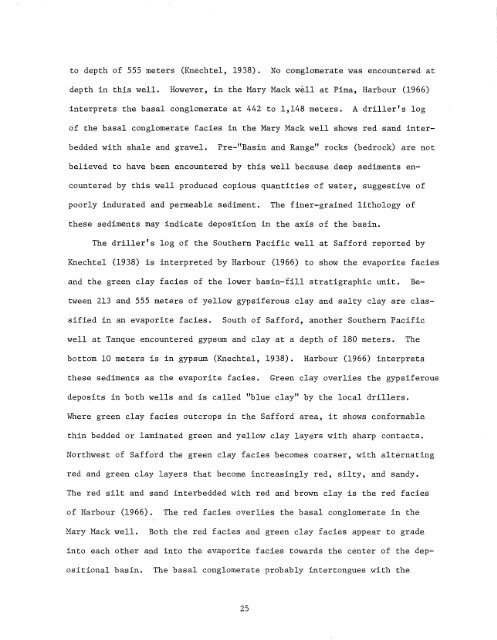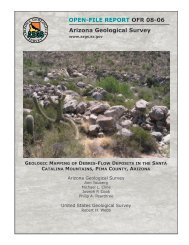geothermal resource potential of the safford-san simon basin, arizona
geothermal resource potential of the safford-san simon basin, arizona
geothermal resource potential of the safford-san simon basin, arizona
Create successful ePaper yourself
Turn your PDF publications into a flip-book with our unique Google optimized e-Paper software.
to depth <strong>of</strong> 555 meters (Knechtel, 1938). No comglomerate was encountered at<br />
depth in this well. However, in <strong>the</strong> Mary Mack well at Pima, Harbour (1966)<br />
interprets <strong>the</strong> basal conglomerate at 442 to 1,148 meters.<br />
A driller's log<br />
<strong>of</strong> <strong>the</strong> basal conglomerate facies in <strong>the</strong> Mary Mack well shows red <strong>san</strong>d interbedded<br />
with shale and gravel.<br />
Pre-"Basin and Range" rocks (bedrock) are not<br />
believed to have been encountered by this well because deep sediments encountered<br />
by this well produced copious quantities <strong>of</strong> water, suggestive <strong>of</strong><br />
poorly indurated and permeable sediment.<br />
The finer-grained lithology <strong>of</strong><br />
<strong>the</strong>se sediments may indicate deposition in <strong>the</strong> axis <strong>of</strong> <strong>the</strong> <strong>basin</strong>.<br />
The driller's log <strong>of</strong> <strong>the</strong> Sou<strong>the</strong>rn Pacific well at Safford reported by<br />
Knechtel (1938) is interpreted by Harbour (1966) to show <strong>the</strong> evaporite facies<br />
and <strong>the</strong> green clay facies <strong>of</strong> <strong>the</strong> lower <strong>basin</strong>-fill stratigraphic unit.<br />
Between<br />
213 and 555 meters <strong>of</strong> yellow gypsiferous clay and salty clay are classified<br />
in an evaporite facies.<br />
South <strong>of</strong> Safford, ano<strong>the</strong>r Sou<strong>the</strong>rn Pacific<br />
well at Tanque encountered gypsum and clay at a depth <strong>of</strong> 180 meters.<br />
The<br />
bottom 10 meters is in gypsum (Knechtel, 1938). Harbour (1966) interprets<br />
<strong>the</strong>se sediments as <strong>the</strong> evaporite facies.<br />
Green clay overlies <strong>the</strong> gypsiferous<br />
deposits in both wells and is called "blue clay" by <strong>the</strong> local drillers.<br />
Where green clay facies outcrops in <strong>the</strong> Safford area, it shows conformable<br />
thin bedded or laminated green and yellow clay layers with sharp contacts.<br />
Northwest <strong>of</strong> Safford <strong>the</strong> green clay facies becomes coarser, with alternating<br />
red and green clay layers that become increasingly red, silty, and <strong>san</strong>dy.<br />
The red silt and <strong>san</strong>d interbedded with red and brown clay is <strong>the</strong> red facies<br />
<strong>of</strong> Harbour (1966).<br />
The red facies overlies <strong>the</strong> basal conglomerate in <strong>the</strong><br />
Mary Mack well.<br />
Both <strong>the</strong> red facies and green clay facies appear to grade<br />
into each o<strong>the</strong>r and into <strong>the</strong> evaporite facies towards <strong>the</strong> center <strong>of</strong> <strong>the</strong> depositional<br />
<strong>basin</strong>.<br />
The basal conglomerate probably intertongues with <strong>the</strong><br />
25

















